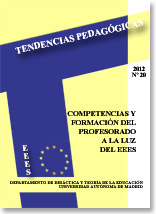Proposal of an inventory of technological resources for the treatment of students with disabilities in the European Education Area Higher
Keywords:
Disability, ICT, EHEA, Inclusivity, Diversity.Abstract
This article presents an initial framework to faculty who approaches the subject of methodological treatment of the disabled with the support of the Information and Communication Technology in the European Higher Education Area (EHEA). We present an inventory of technology resources which can help to improve learning and academic integration of university students with disabilities. ICT can play a key role in overcoming the barriers faced by people with disabilities in the EHEA. The technological resources provide multiple functions for this people, facilitating communication, access and information processing, cognitive development, and self-adaptation to the environment, enhancing personal development and learning autonomy.Downloads
References
Alfaro, I.J. (2007). La respuesta organizativa y metodológica de la Universidad ante una nueva tipología de estudiantes. Valencia: Universidad de Valencia,
Servicio de Publicaciones.
Alonso, A. y Díez, E. (2008). Universidad y Discapacidad: indicadores de buenas prácticas y estándares de actuación para programas y servicios. Siglo Cero, 39, 82-98.
Asunción, J.V. y Fichten, C.S. (2003). Are You Considering All Students, Including Those with Disabilities, When Planning for Technology Integration? Educational Technology, 43, 49-52.
Bolívar, A. (2008). El discurso de las competencias en España: Educación Básica y Educación Superior. Red U. Revista de Docencia Universitaria, número monográfico. Consultado el 12 de agosto de 2012 en:
redaberta.usc.es/redu/index.php/REDU/article/download/70/52
Castellana, M., Giné, C., Dotras, P., López, P., Farriols, N., Vilaregut, A. y Sala, I. (2005). Estudiantes con discapacidad en las aulas universitarias (No.
EA2005-0075). Barcelona: Universitat Ramon Llull.
Diéz et al., (2011). Espacio Europeo de Educación Superior: estándares e indicadores de buenas prácticas para la atención de estudiantes universitarios con discapacidad. Colección Investigación 6/2011. Salamanca: Publicaciones del INICO
Díez, E. y Verdugo, M.A. (1997). La teleformación como alternativa a la formación presencial para personas con discapacidad. En M. A. Verdugo, C. Caballo, F. B. Jordán, M. Crespo, C. Jenaro, M. I. Tena, F. Sáinz, y E. Díez
(compiladores). Actas de las II Jornadas de Investigación sobre Personas con Discapacidad (pp. 311-318). Salamanca: Gráficas Varona.
Doyle, C. y Robson, K. (2002). Accessible Curricula: Good Practice For All. Wales: UWIC Press.
Gardiner, V. y Anwar, N. (2001). Issues in providing learning support for students with mobility impairments undertaking fieldwork and related activities. Gloucestershire, UK: Geography Discipline Network (GDN).
Irvall, B. y Nielsen, G. S. (2005). Access to libraries for persons with disabilities: checklist. The Hague: International Federation of Library Associations.
Kinash, S., Crichton, S. y Kim-Rupnow, W. (2004). A Review of 2000-2003 Literature at the Intersection of Online Learning and Disability. American Journal of Distance Education, 18(1), 5-19.
Lucas, S. (2007). Desarrollo de competencias desde la Enseñanza Universitaria. Armonización con la Educación Secundaria y el mercado de trabajo. Electronic Journal of Research in Educational Psychology, 11(5), 125-158.
Marqués, P. (2001). Algunas notas sobre el impacto de las TIC en la Universidad. Educar, 28, 201, 83-98.
Martínez, J. A. (2010). El Espacio Europeo de Educación Superior (EEES) y nuevo rol del estudiante universitario. Cuadernos de educación y desarrollo, 2(16).
Mehlinger, H.D. y Powers, S.M. (2002). Technology & teacher education: A guide for educators and policymakers. Boston: Houghton Mifflin.
Peralta, A. (2007). Libro Blanco sobre universidad y discapacidad. Madrid: Real Patronato sobre Discapacidad.
Poblete, M. y Villa, A. (2007). Aprendizaje basado en competencias. Una propuesta para la evaluación de competencias genéricas. Bilbao: Mensajero.
Riesco González, M. (2008). El enfoque por competencias en el EEES y sus implicaciones en la enseñanza y el aprendizaje. Tendencias Pedagógicas, 13. 85-88.
Rose, D. H., Meyer, A. y Hitchcock, C. (Eds.). (2005). The universally designed classroom: Accessible curriculum and digital technologies. Cambridge, MA: Harvard Education Press.
Sanz, M. L. (2010). Competencias cognitivas en Educación Superior. Madrid: Narcea.
Vázquez Cano, E y Sevillano García, M.ª L. (2011). Educadores en Red. Elaboración de los Materiales audiovisuales para la enseñanza. Madrid: Ediciones Académicas-UNED.
Verdugo, M. A. y Campo, M. (2005). Análisis de servicios y programas universitarios de apoyo a estudiantes con discapacidad en las universidades españolas. Consultado el 12 de agosto de 2012 en:
sid.usal.es/idocs/F8/FDO17238/analisis_servicios.pdf
